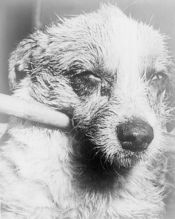Difference between revisions of "Rabies"
Jump to navigation
Jump to search
m (Text replace - "Category:Neurological_Disorders_-_Horse" to "Category:Neurological Diseases - Horse") |
|||
| Line 113: | Line 113: | ||
[[Category:Neurological Diseases - Cat]][[Category:Cat Viruses]] | [[Category:Neurological Diseases - Cat]][[Category:Cat Viruses]] | ||
[[Category:Neurological Diseases - Dog]][[Category:Dog Viruses]] | [[Category:Neurological Diseases - Dog]][[Category:Dog Viruses]] | ||
| − | [[Category:Cattle]] | + | [[Category:Cattle Viruses]][[Category:Neurological Diseases - Cattle]] |
| − | [[Category:Sheep]] | + | [[Category:Sheep Viruses]][[Category:Neurological Diseases - Sheep]] |
| − | [[Category:Pig]] | + | [[Category:Pig Viruses]][[Category:Neurological Diseases - Pig]] |
| − | [[Category:Goat]] | + | [[Category:Goat Viruses]][[Category:Neurological Diseases - Goat]] |
[[Category:To_Do_-_Clinical/Viruses]] | [[Category:To_Do_-_Clinical/Viruses]] | ||
[[Category:Neurological Diseases - Horse]] | [[Category:Neurological Diseases - Horse]] | ||
[[Category:Horse_Viruses]] | [[Category:Horse_Viruses]] | ||
Revision as of 12:53, 17 January 2011
Virulence and Pathogenesis
- Rabies is moderately resistant: it can survive well in dark places at low temperatures for several days
- Infection occurs through a penetrating bite in which virus is transmitted via saliva
- Incubation period is variable but can be long (10 days to 12 months), and increases with distance of the bite to the CNS
- 80% show signs within 4 months
- Primary replication of the virus occurs in the muscle
- The virus gains access to nervous tissue and travels toward the brain, where it continues to replicate
- It then migrates down cranial nerves to infect salivary glands and the cornea
- Virus is shed in saliva and tears and can be shed BEFORE the onset of classical signs
- The onset of clinical signs in dogs and cats includes:
- Behavioral changes
- Pyrexia
- Salivation
- Dilation of pupils
- Two forms of the virus exist:
- Furious form:
- Common to cats and dogs
- Abnormal aggression, salivation, and attack without provocation
- Disordered wandering, "copulatory" movements.
- Incoordination, convulsions, coma and death within 3-10 days
- Dumb form
- May or may not follow Furious form
- Common to ruminants and horses
- Ruminal tympany, tenesmus, diarrhoea
- Paralysis of lower jaw, drooling saliva, tremors and progressive paralysis
- In dogs, a change in voice may be observed (bellowing)
- Furious form:
- Human infection is characterized by hydrophobia
Epidemiology
- Rabies is a NOTIFIABLE zoonosis
- Rabies is found worldwide, though currently considered exotic to the UK and Australia
Host Range:
- All mammals are susceptible
- Very susceptible: foxes, jackals, wolves
- Susceptible (10,000x virus necessary to infect): cats, rodents, bats, skunks, cattle, mongooses
- Moderately susceptible (100,000x virus necessary to infect): dogs, sheep, goats, horses, primates
- Isolates can show to some species specificity in their reservoir host
Reservoir species by region:
| Region | Reservoir Species |
|---|---|
| Europe | Red fox |
| Russia, Turkey, Middle East | Dog, Raccoon |
| USA | Raccoon, Fox, Skunk |
| Africa | Dog, Jackal, Mongoose |
| Asia | Dog, Mongoose |
| South America | Dog, Vampire bat |
| Worldwide | Insectivorous Bats |
- The current position of DEFRA holds bat lyssaviruses to be present in the UK
- Human infection and death an occur after infection with bat rabies
- Nocturnal bat bites account for 50% of human cases in the USA
- Humans develop disease but excrete little virus
- Immune recovered animals are rare, but are not shown to be infections
Diagnosis
- Isolate and monitor for clinical signs
- In the field:
- Remove brain core sample via straw through occipital foramen in the direction of an eye
- Place contents in a 50% glyerol/PBS for FAT or virus isolation, or in 10% formaldehyde for histology
- Whole head can also be removed and sent to lab
- In the lab:
- Fluorescent Antibody Test (FAT) on smears or frozen sections of hippocampus or cerebellum should show presence of Negri bodies
- Being replaced by testing for monoclonal antibodies to nucleoprotein
- Histological detection of Negri bodies using Mann's or silver stains
- Intracerebral inoculation of mice followed by FAT testing of brain smears of affected mice
- RT-PCR on brain or saliva can be performed to determine genotype
- Fluorescent Antibody Test (FAT) on smears or frozen sections of hippocampus or cerebellum should show presence of Negri bodies
Rabies Control
For countries where rabies is considered exotic:
- 6 month quarantine of carnivores and ruminants (Norway, Sweden, Portugal, Australia, New Zealand)
- In the UK, this has been replaced by the Pet Travel Scheme (PETS)
For virus-endemic countries:
- Control in pets:
- Annual Vaccination:
- Antigenicity allows a single antigenic type to vaccinate
- Inactivated virus or canarypox recombinant viruses
- Control of stray population
- Muzzling in public
- Annual Vaccination:
- Control of wildlife reservoir hosts:
- Feeding vaccinated bait
- Secondary consequence of increasing reservoir host population (eg European foxes)
- Control in humans
- Prevention by vaccination with a single booster if bitten
- The current vaccine is grown in human diploid cells (HDCV) and is BPL-inactivated, and therefore costly
- Developing countries utilize older vaccines passaged from a 1939 case ("Flury" vaccines)
- If bitten and unvaccinated:
- Clean and disinfect wound
- Human anti-rabies immunoglobulin administered around bite
- Intramuscular vaccination program: 2 dose-1 dose-1 dose at 0, 7, and 14 days post-bite
- Prevention by vaccination with a single booster if bitten
For more on Rabies control in Europe, see here
Categories:
- Rhabdoviridae
- Zoonoses
- Neurological Diseases - Cat
- Cat Viruses
- Neurological Diseases - Dog
- Dog Viruses
- Cattle Viruses
- Neurological Diseases - Cattle
- Sheep Viruses
- Neurological Diseases - Sheep
- Pig Viruses
- Neurological Diseases - Pig
- Goat Viruses
- Neurological Diseases - Goat
- To Do - Clinical/Viruses
- Neurological Diseases - Horse
- Horse Viruses
